…and many meats, eggs, veggies, fruits, organs and claws, say pet nutritionists, instead of sterile and nutrition-less packaged food, if you want them to live long
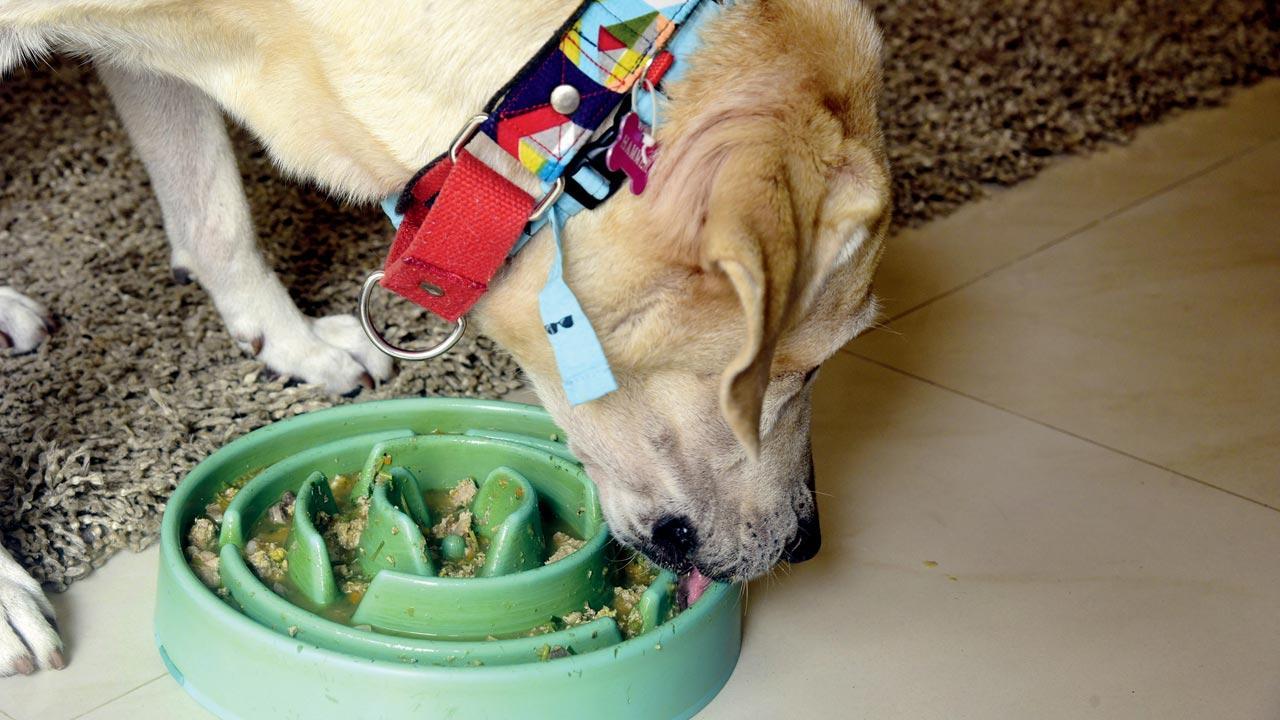
After a consistent high creatinine level scare, nine-year-old Hammer shifted to a diet whose bulk is meats of various animals and their organs. Pics/Atul Kamble
Gabbar Singh’s daily bowl of food has a large chunk of uncooked animal protein and organs on rotation, all sourced directly from a halal butcher: Duck, quail, goat, buffalo, chicken, or pork. It’s supplemented with some fish: sardine, anchovies or ravas. “Norwegian salmon on his birthday,” informs the Alsation’s parent Adrija Majethia, “or rabbit or emu. Lately, he’s developed a taste for kangaroo, venison and veal. My brother gets dehydrated chunks or jerkies of these when he visits from Australia.” There are brains, gizzards, liver, kidney, lungs, oesophagus, eyeballs and hearts from these animals too.
That’s just the main component of the meal—with it comes a gravy of red or green soup (made from vegetables of that general colour) with pepper and turmeric; occasionally, bone broth, a dash of fermented vegetables or sauerkraut, toppers such as algae, spirulina; duck, chicken or quail eggs, a teaspoon rotation of oils such as coconut (cold-pressed and organic, of course), flaxseed, pumpkin seeds, salmon, sardine, olive; chia seeds, berries. Ice-cream, kharvas and paneer—his favourites—to coax him for a difficult task. “His carb content comes from doggie biscuits he eats throughout the day; and he loves his ghee-wali rotli,” says the Matunga resident.
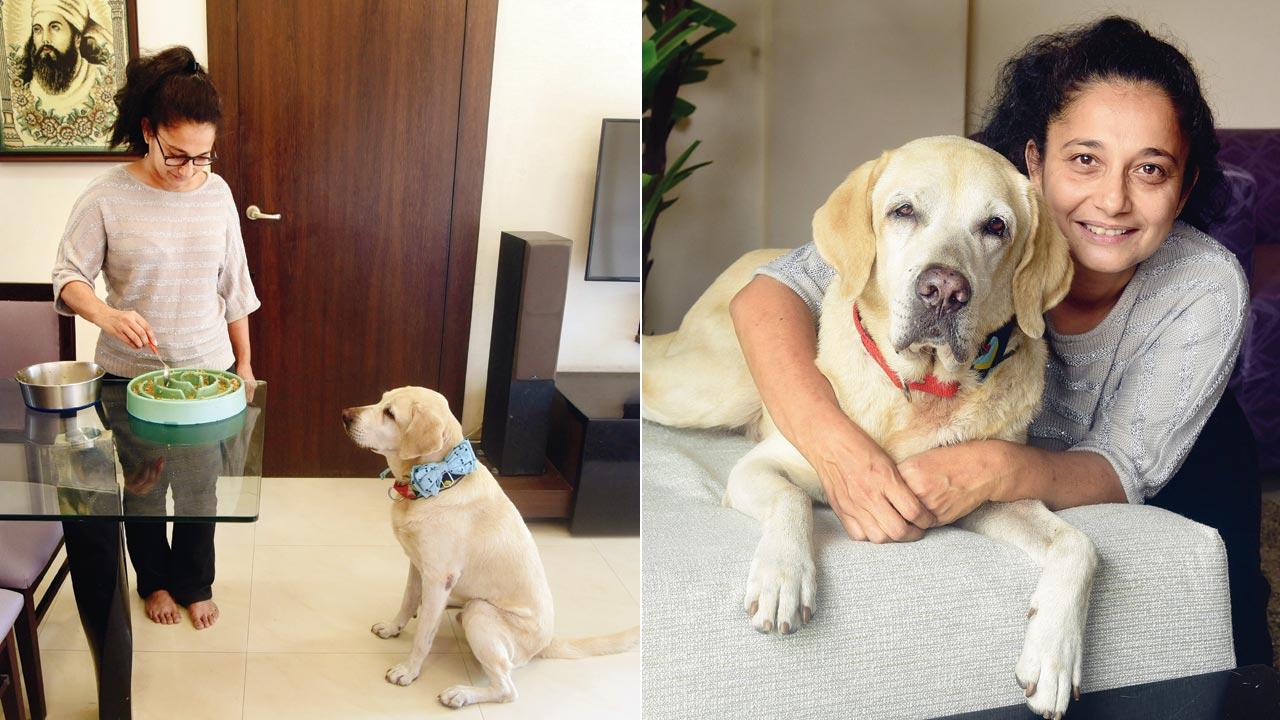
This may seem like the indulgence of a childless human, but it’s not. Increasingly more research is showing that the game changer for longevity, and healthy longevity, for our pets is varied nutrition from fresh foods that are human grade. Not dried, packaged pellets—kibble, colloquially—neither unchanging variations of rice/roti-chicken, rice/roti-milk, rice/roti-yoghurt. Bobi, a Portuguese dog who Guinness World Records determined as the oldest dog ever, died at age 31. Scientists will be studying his DNA to find the secret to a long, healthy and happy life—the only wish every pet parent makes on a falling star. Bobi, living in a village, got lots of exercise, exposure to nature (and its immunity-building bacteria), and varied fresh food. The seminal book on dog health—The Forever Dog by Rodney Habib (@rodneyhabib) and Dr Karen Shaw Becker (@drkarenbecker)—repeatedly emphasises on these three ingredients for healthy canine life.
The India dog food market size reached $2.4 Billion in 2022. And yet, it is unregulated by a governing body as it is by the FDA (Food and Drug administration body) in the USA. The FDA mandates that ingredients on the packet are listed in order of volume. So, if the bag says: Chicken protein, fish, cornmeal, rice, etc… it is mandatory that the first five products make up 85 per cent of the kibble. “In India,” informs Dr Karishma Gupte, veterinary surgeon and director of Vetbiotics Animal Healthcare Pvt Ltd, “If the packet says Ocean Fish, it doesn’t mean it has fish in it. Just using artificial fish flavouring gives the manufacturer the right to advertise it so.” Dr Gupte is among the handful of vets who will take the time to guide a pet parent about what to feed their cat or dog, and in what proportions. “We learn enough about nutrition in the first five basic years of medical school, and can opt for it in the additional two, if we pursue a Masters. It’s just a pain to calculate, but pet parents can insist on it and the doctor may charge a bit more but it will add years to your pet’s life.”
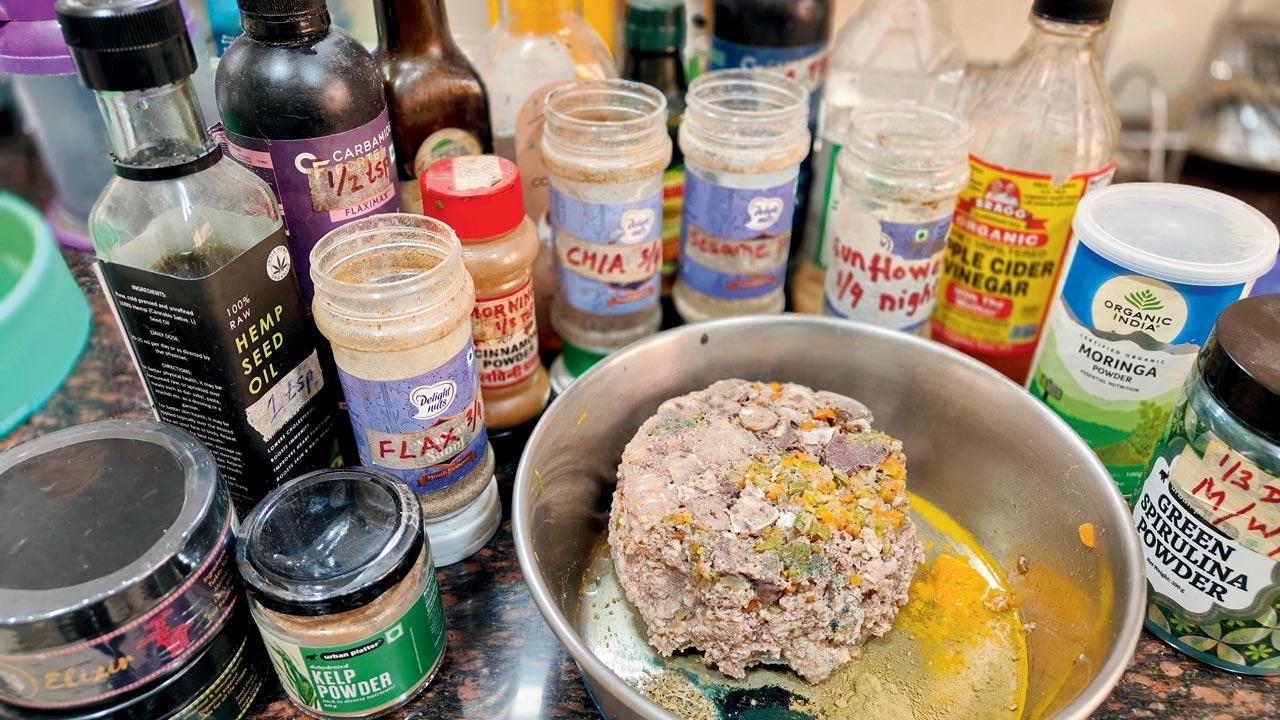 Mahafrin Irani fortifies Hammer’s meals with superfoods such as green spirulina, hemp powder, anchovy paste, apple cider vinegar (unfiltered) and CBD oil
Mahafrin Irani fortifies Hammer’s meals with superfoods such as green spirulina, hemp powder, anchovy paste, apple cider vinegar (unfiltered) and CBD oil
During the COVID-19 pandemic, Dr Gupte ran a basic nutrition course through WhatsApp to educate pet parents and professionals on how to calculate metabolizable energy their dog needs at their age and weight; and from what their primary source of energy is (fat, first, then animal protein), and how much carbohydrates they need in a day (none). The proceeds went towards the feeding of stray dogs through the WSD. “In my practice,” says Dr Gupte, who is from Mumbai, but now lives in Chennai, “I observed that most dogs who came for kidney and liver trouble were on a diet purely comprising kibble. Stray dogs that lived on the streets were the healthiest—scavenging a variety of freshly discarded foods from community dustbins, butchers’, fish market, food stalls and restaurant wastes.”
The reason for this is embedded in the process of how kibble is made. It mainly comprises non-human grade waste from the meat and leather industry: flesh of animals that died through disease, beaks, claws, bones, skin. Then this is bulked up with fillers, which are also food industry by-products and not fit for human consumption, such as soya, wheat, rice, beet pulp, cornmeal, etc. “These go through an extrusion process,” explains Archana Das, co-founder of Three Tails, a pre-packed fresh food meal subscription service. “They are powdered at high temperatures—which kills all the vitamins and minerals—and shaped into pellets. Then fats, nutrients preservatives, minerals etc are artificially added to them, along with a whole layer of lard and flavouring to get the dog interested.”
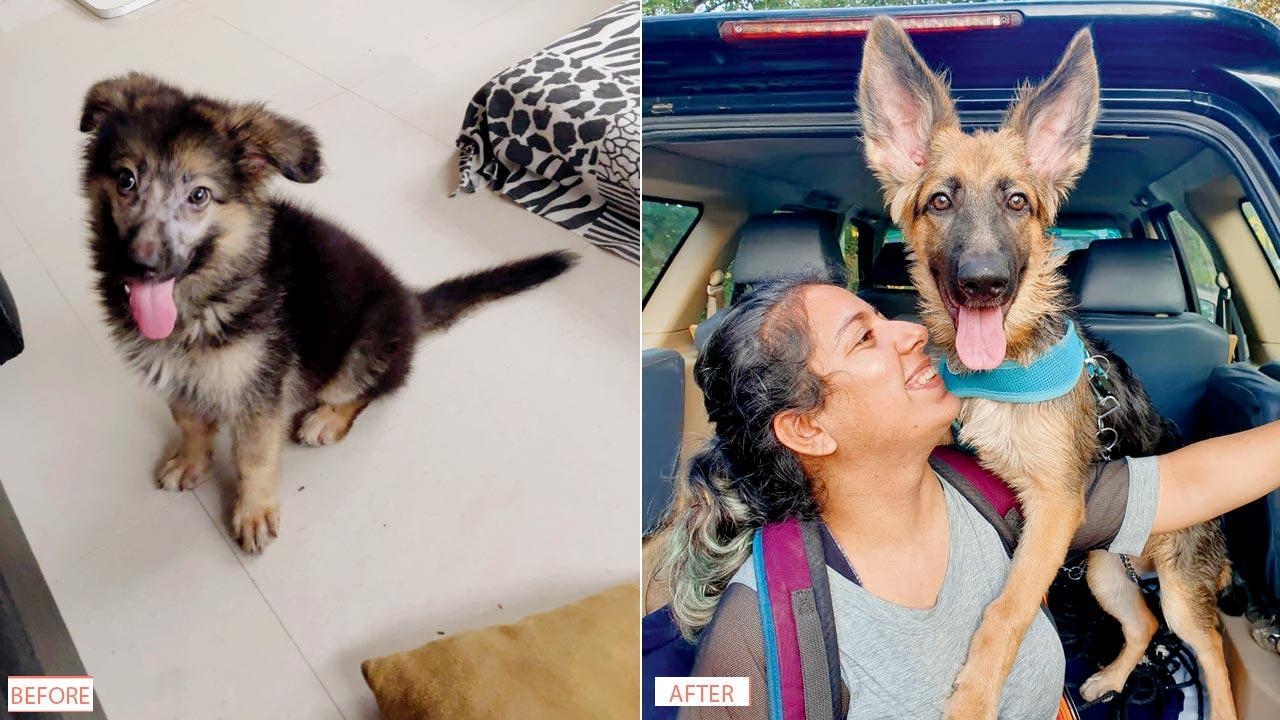 Gabbar Singh came to Adrija Majethia with severe health problems—his general immunity was low, and he puked and pooped bile. Upon her vet’s suggestion, she moved to fresh food and his health did a U-turn within a fortnight
Gabbar Singh came to Adrija Majethia with severe health problems—his general immunity was low, and he puked and pooped bile. Upon her vet’s suggestion, she moved to fresh food and his health did a U-turn within a fortnight
This pulls down the bio-availability—the ratio of nutrients that can be absorbed—of the food. Though it says so on most packages, most people are not specifically informed that kibble has to be soaked in water (or bone broth) to be made digestible—else, it turns diuretic—pulling moisture from the organs for digestion, and also burdening them with the amount of enzymes needed to break it down.
Fresh food—in all its variety of leafy and root vegetables, yams, herbs, mushrooms, algae, fruits, oils, animal muscle, muscle and secretary organs (heart or liver), bones, scales, skin (animal, fruit and vegetable) and even seeds such as pumpkin, flaxseed—is not only highly bioavailable to the dog, as in us, it fortifies the system. And is full of moisture. “Garlic, which is a highly controversial ingredient, actually makes the blood unpalatable, warding off parasites such as ticks and fleas, as does apple cider vinegar,” says Aneema Jena, also co-founder of Three Tails, which operates out of Govandi.
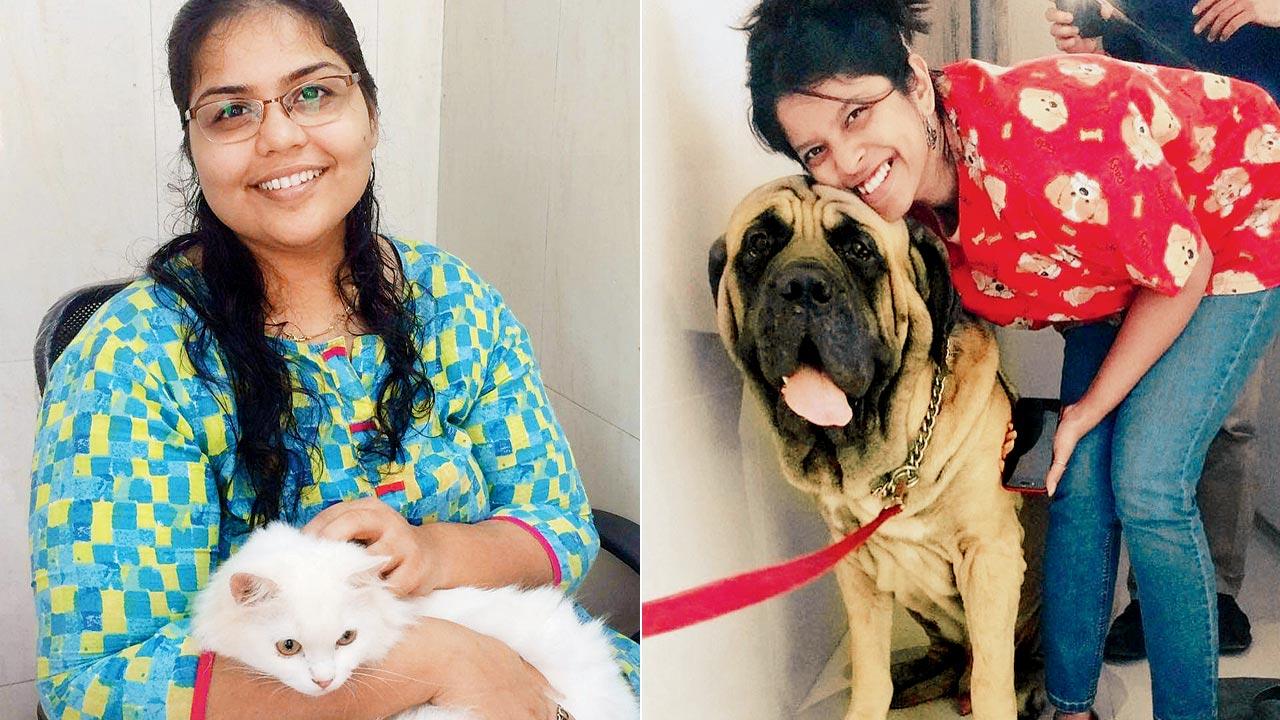 Dr Karishma Gupte, Veterinary surgeon; (right) Dr Nameeta Nadkarni, Veterinary surgeon
Dr Karishma Gupte, Veterinary surgeon; (right) Dr Nameeta Nadkarni, Veterinary surgeon
Garlic also has anti-fungal properties, and powdered pumpkin seeds are natural dewormers—both evangelised heartily by holistic canine practitioner Lee Georgina of Georgina’s Kitchen (Bengaluru). Georgina brings in Chinese medicine and other natural modalities and offers toppers such as dehydrated fish meal or algae and superfoods such as spirulina, shitake mushrooms and berries. The study that branded garlic as poisonous to dogs was done in the 1970s and inordinate amounts of garlic—kilos of it; a quantity that would make water poisonous to human beings—was fed to them. Other fresh food proponents such as Carni Kitchen and Romeo’s Kitchen—both based in Mumbai—ground their consultation and dabba services in nutrition courses from international universities. Jena and Dutta hold diplomas in canine nutrition from International School for Canine Psychology and Behaviour in the UK.
Georgina has answered concerns about the hygiene of raw meats in a podcast, Unleash with Shirin, saying that “dogs already have a small amount of salmonella in their digestive tract. Also, their digestive process is so fast that bacteria does not affect them as it does us.”
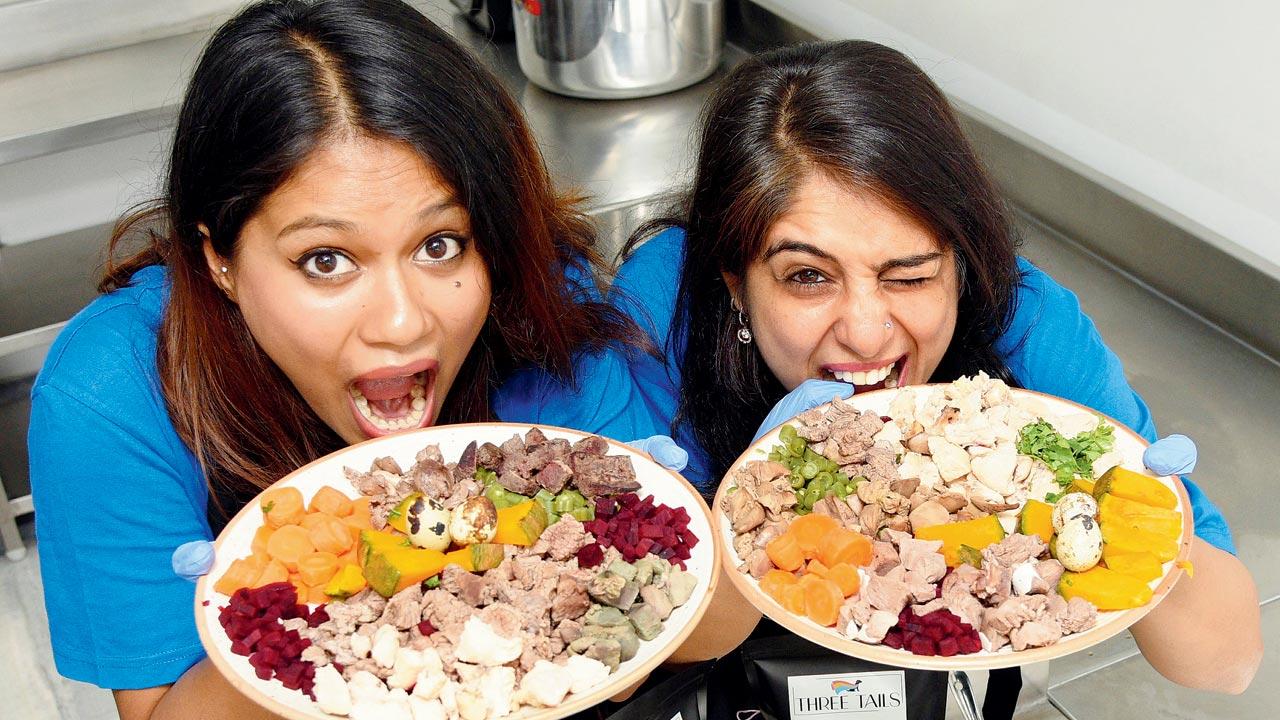 Having studied canine nutrition, Aneema Jena and Archana Das of Three Tails prepare well-balanced meals comprising a mix of seasonal vegetables, meat and organs from various animals and birds, as per the dog’s age, ideal weight and breed. Pics/Satej Shinde
Having studied canine nutrition, Aneema Jena and Archana Das of Three Tails prepare well-balanced meals comprising a mix of seasonal vegetables, meat and organs from various animals and birds, as per the dog’s age, ideal weight and breed. Pics/Satej Shinde
So why is kibble so widely prescribed and pushed, especially by vets? Like the human pharma mafia, vets enjoy a margin of 20 to 25 per cent on the bags of kibble sold through their clinics. Many of the senior ones have a higher stake in the profit by facilitating their entry into the fledgling petcare market a decade or so ago. They are flown to conferences abroad, and wooed with cruises.
Breeders are given bags at discounted rates, so the flavour of that particular kibble is already familiar to the puppy through its mother’s milk. And it can be easily sold to the new parent who takes that puppy home, knowing that it will adapt quickly.
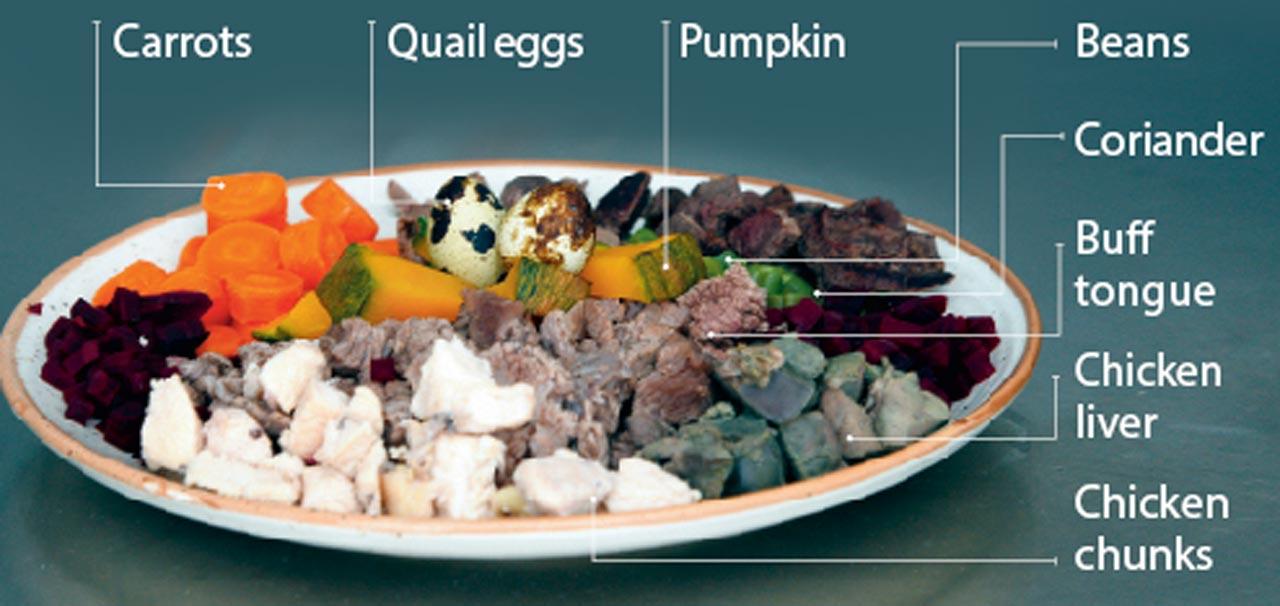
However, as most pet parents will tell you, the dog soon refuses the food because no species in the world voluntarily eats dehydrated packaged food. Else, we would all be living off spirulina pills instead of dreaming about gongura pickle in the middle of the day.
“The very act of eating—the gnawing of bones, tearing of flesh, texture and smell of the vegetables are serotonin releasers because they gratify the senses,” says Dutta and Jena. “You have to look at how a dog would eat in nature—it would first go for the belly of the prey and eat the organs which are rich in fat. Then the flesh, and gnawed at the bones leisurely, maybe even later. Grains and vegetables—a very small amount—would come from the kill’s digestive tract. The skin, fur, claws, beak and feathers would be roughage. That’s why dogs have highly acidic stomachs—to be able to break down all this.” This also releases glucose steadily into the dog’s bloodstream, and doesn’t spike it like kibble, which expands in the stomach to fill it up but gets digested quickly. Authors of The Forever Dog found that though “dogs have no need for carbohydrates… the average bag of grain-based food is often more than 50 percent carbs, largely from insulin-raising corn and potato.” The proof is in the poop: Dogs on fresh food have well-formed, but lower output because so much of the food is bio-available; kibble excreta is fluffy, more in volume and not easy to pick up after.
But not every vet prescribes kibble with a nefarious purpose: Dr Nameeta Nadkarni, a veterinary surgeon and cancer specialist prescribes premium kibble—but not the grain-free ones—for vegetarian households. “Home-cooked meals are often misinterpreted to mean rice and chicken, or milk and rice. I don’t advise it unless under the guidance of a nutritionist; it’s hard to calculate and balance the proportions of the meal at home,” says the vet who practises at The Cancer Vet in Chembur. “For instance, a dog needs 30 gms of chicken meat per kilo of body weight a day. That’s almost a kilo of chicken every day for a medium-sized dog, and may not be economically viable. A puppy’s nutritional requirement changes every three months. So until full skeletal growth is achieved—at 10 to 11 months, it is better to put the dog on a premium packaged food brand (wet food options are available), but I wouldn’t recommend grain-free varieties as studies link it to early heart disease.”
The current ‘quality’ of our dogs also necessitates closer attention to diet. The quality of genetics has been dropping with each breeding cycle. Gabbar came from a dubious breeder, with patches of hair loss and discolouration (indicative of kidney under function) on his skin. “He wasn’t as energetic as other puppies and not growing at the expected rate either,” says Majethia, who then ran a meal subscription business, “Dr Akshay Shah at AcuVet suggested a special packaged diet, and when that didn’t work, recommended I try fresh food.” Being a Kutchhi vegetarian household, cooking meat at home was not an option. “My friends offered to cook the meals and send them over, but then I consulted Carni Kitchen, who recommended raw meat diet and gave me the resources to source it from. This took away the need to even get separate vessels. They told me the required freezing period for each kind of meat to kill the bacteria. I also source the bone broth, and only make the soups at home, which both of us share.”
Within 15 days of the diet, Gabbar was livelier and bouncing with puppy mischief. He was also able to learn commands quickly—a balanced gut is linked to better absorption of information in dogs as well as humans—and soon started “training” Majethia back, manipulating her to get treats.
“Once you get the hang of it,” says Dr Gupte. “It’s just a matter of putting a pressure cooker of your dog’s food next to yours. Your grocery lists sync because you eat the same vegetables. That’s the gamechanger—the human-grade quality of ingredients.” The only human foods poisonous to dogs are chocolate (the theobromine in it), onions and fruits seeds from apples or grapes, due to their cyanide content, and avocado pits.
Hammer, who turned nine years old on the day of his shoot with mid-day, turned to fresh food during the pandemic when his creatinine levels consistently showed up borderline high level. Till then, his mother Mahafrin Irani fed him an ad-hoc diet of kibble, rice, millet and chicken, moong daal, and veggies. “I didn’t know the correct proportions, there was less chicken and more rice and vegetables, but the kibble was very helpful when we took road trips with him, like to Himachal for a month,” says the interior designer from Napean Sea Road, “He was always lean, but his yearly check-ups showed that his creatinine values were slowly increasing. A vet put him on special renal packaged food, but then he lost a lot of muscle. I finally consulted Georgina, who said this was not a case of renal or kidney failure, just a lack of varied nutritional spectrum.”
So now the yellow Labrador’s slow feeder bowl has 650 gms of meat on rotation—chicken, pork, duck, lamb, buffalo or goat; 150 gms of organs; 100 gms of vegetables, shitake or medicinal mushrooms, fish paste for Omega acids, dried shrimp, powdered seeds (sunflower, flax, sesame, hemp), and sprinklings of superfoods such as moringa, spirulina, hemp, and good fats such as avocado and MCT oil. Seasonal berries—strawberries, blueberries, raspberries, cranberries—and fruits such as papaya, watermelon, avocado, kiwi, pomegranate, apples musk melon are his frozen treats. “I just cook his food altogether in batches and freeze individual portions in boxes, and even carry these on road trips packed in ice,” she says.
Extra much?
Consider this: In 2016, archaeologists unearthed 26,000-year-old foot canine paw prints alongside that of a child inside Chauvet Cave, a Paleolithic site in France. A child, torch in hand, was exploring the cave with her dog. Today, pets are substitutes for many Gen-Xers and millennials—living with us against their will, with no fundamental freedoms of choice over what they eat, when they eat, whom they befriend and where they go. Assuring them a healthy, pain-free life is a small payback, no?
 Subscribe today by clicking the link and stay updated with the latest news!" Click here!
Subscribe today by clicking the link and stay updated with the latest news!" Click here!










